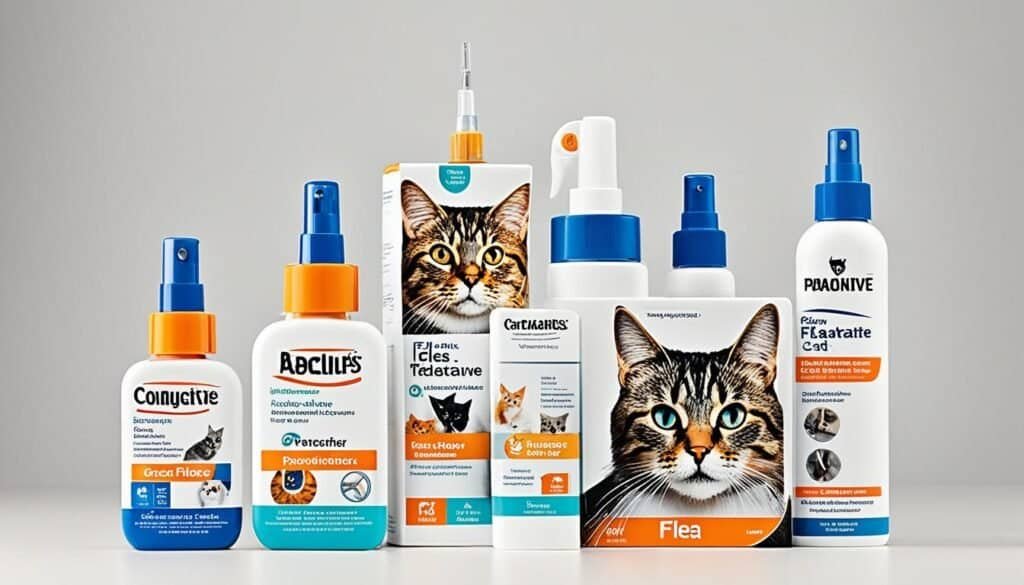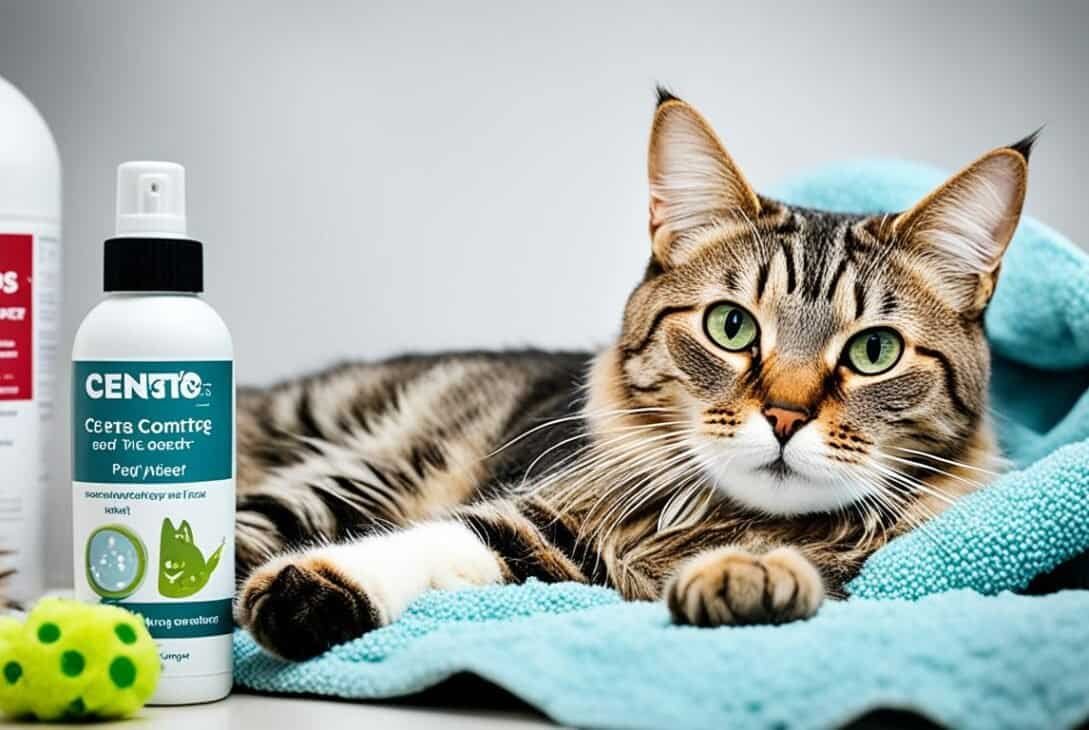Fleas and ticks can be a nuisance for cats, causing various health issues such as skin irritation, itching, and the transmission of diseases. It is crucial to take preventive measures to protect your feline friend. In this article, we will explore the best practices for cat flea and tick prevention, including the types of preventatives available and the importance of year-round prevention.
Key Takeaways:
- Fleas and ticks can cause skin irritation, itching, and transmit diseases to cats.
- Choosing a safe and effective flea and tick preventative is essential for your cat’s well-being.
- Collars, topical treatments, and oral medications are common options for cat flea and tick prevention.
- Year-round prevention is recommended to protect against indoor flea infestations and active ticks.
- Recognizing signs of infestation, such as visible fleas or ticks, excessive scratching, and irritated skin, is important for prompt treatment.
Understanding Fleas and Ticks
Fleas and ticks are common external parasites that can affect cats. It’s important to understand the basics about these pests and the potential health risks they pose. Dogs can pick up fleas and ticks from their environment, but cats can also get them from other pets or even humans.
Fleas can cause various health issues, including tapeworm infections and skin allergies. These tiny insects can cause severe itching, discomfort, and irritation to cats. Additionally, some cats may develop an allergic reaction to flea bites, leading to excessive scratching and hot spots on their skin.
Ticks, on the other hand, are known carriers of harmful diseases such as Lyme disease and Rocky Mountain spotted fever. When a tick bites a cat, it can transmit pathogens into their bloodstream, potentially causing serious illness. Prompt removal of ticks is crucial to avoid the transmission of these diseases.
To protect your cat from these pests and the diseases they carry, it’s essential to use flea and tick preventatives. These preventatives are medications specifically designed to deter fleas and ticks from biting cats and to prevent the spread of diseases. Using the right preventatives can help keep your cat safe and healthy.
Consulting with your veterinarian is important when choosing the best flea and tick preventatives for your cat. They can provide expert guidance based on your cat’s specific needs and health status.
By understanding the risks associated with fleas and ticks and utilizing effective preventatives, you can protect your feline companion from these pests and the diseases they transmit.
Types of Flea and Tick Preventatives for Cats
When it comes to protecting your furry feline friend from fleas and ticks, there are several types of preventatives available. Each option offers unique benefits and considerations, allowing you to choose the best product for your cat’s specific needs. Here are some popular types of flea and tick preventatives:
1. Collars
 Collars, such as Seresto, are a convenient and effective way to keep fleas and ticks at bay. These collars not only repel these pesky parasites but also prevent tick attachment. It’s important to ensure the collar fits properly and is comfortable for your cat to wear.
Collars, such as Seresto, are a convenient and effective way to keep fleas and ticks at bay. These collars not only repel these pesky parasites but also prevent tick attachment. It’s important to ensure the collar fits properly and is comfortable for your cat to wear.
2. Topical Treatments
Topical treatments, like K9 Advantix II and Vectra 3D, provide comprehensive protection against fleas and ticks. These treatments repel and prevent tick attachment, ensuring your cat remains bite-free. However, it’s important to note that some topical treatments, such as Frontline, do not repel ticks but can effectively kill them after attachment.
3. Oral Preventatives
Oral preventatives, such as Nexgard and Simparica, offer a convenient and hassle-free solution for flea and tick prevention. These medications are administered orally and work by killing ticks rapidly. While oral preventatives do not repel ticks, they provide fast-acting protection against these parasites. It’s essential to consult with your veterinarian to determine the most suitable oral preventative for your cat’s needs.
When choosing the best option for your cat, consider factors such as the product’s frequency of application, prescription requirements, and efficacy. Additionally, consult with your veterinarian to ensure the chosen preventative is safe and appropriate for your cat’s individual health requirements.
By investing in effective flea and tick preventatives, you can protect your cat from potential health risks and ensure a happy and healthy life for your beloved feline companion.
Importance of Year-Round Prevention
Year-round prevention is essential for effective cat flea and tick prevention. Many cat owners mistakenly believe that fleas and ticks are only a concern during warmer months. However, it’s important to understand that these pests can pose a risk to your cat and your household throughout the year.
Even during the winter months when temperatures drop, fleas can still thrive indoors where they are protected from the cold. Your cozy home provides an ideal environment for fleas to reproduce and multiply, leading to a full-blown infestation. Ticks can also remain active at lower temperatures, posing a risk not just to your cat but also to you and your family.
Fleas and ticks can easily find their way into your home, hitching a ride on your pet or even on your shoes and clothing. Once inside, they can quickly infest your living space, making it challenging to eradicate them completely.
By implementing year-round prevention, you can protect your cat from flea and tick infestations and minimize the risk to your household. Regular preventive measures, such as using appropriate flea and tick treatments and consistently checking for signs of infestation, can help keep these pests at bay.
Remember, prevention is always better than dealing with an infestation. Taking proactive steps to prevent fleas and ticks year-round will ensure the health and well-being of your beloved feline companion.

In the next section, we will discuss the signs of flea and tick infestation in cats and how to recognize them.
Signs of Flea and Tick Infestation in Cats
It’s important to recognize the signs of flea and tick infestations in cats. By being aware of these signs, you can take prompt action to address the issue and ensure the well-being of your feline companion.
One of the most obvious signs of a flea or tick infestation is the presence of visible fleas or ticks on your cat’s fur. These tiny parasites can often be seen crawling or jumping around, especially in areas with less fur such as the belly, ears, or tail.
Excessive scratching is another common sign of a flea or tick infestation. Cats infested with these pests will often scratch themselves obsessively, attempting to relieve the discomfort caused by the bites. Pay attention if you notice your cat scratching more than usual or focusing on specific areas of their body.
In addition to scratching, you may also notice that your cat has red or irritated skin. Flea and tick bites can cause inflammation and irritation, leading to redness and discomfort. If you observe any changes in your cat’s skin tone or notice areas of heightened sensitivity, it’s important to investigate further.
Scabs and flakes on your cat’s skin can also indicate a flea or tick infestation. These parasites can cause skin allergies and irritations, leading to the formation of scabs and the shedding of flakes. Regularly check your cat’s fur and skin for any signs of these abnormalities.
Excessive grooming is another sign to watch out for. Cats are known for being clean animals, but when faced with a flea or tick infestation, they may resort to excessive grooming in an attempt to remove the pests. Excessive grooming can lead to hair loss, skin damage, and even secondary infections.
If you notice any of these signs, it’s crucial to consult with a veterinarian for appropriate treatment options. Flea and tick infestations can cause discomfort and can also lead to the transmission of diseases to both cats and humans. Addressing the issue promptly and effectively is essential for the well-being of your cat and the overall health of your household.
Choosing the Right Flea and Tick Preventative for Your Cat
When it comes to choosing a flea and tick preventative for your cat, there are several important factors to consider. By taking these factors into account, you can ensure that the product you select is the best fit for your cat’s specific needs and circumstances.
Species and Age
Firstly, consider your cat’s species and age. Some flea and tick preventatives are formulated specifically for cats, while others may be designed for dogs or other animals. Additionally, certain products may have age restrictions, so it’s important to choose an appropriate preventative based on your cat’s age.
Application Method Preferences
Another factor to consider is your preference for the application method. Flea and tick preventatives come in different forms, such as topical treatments and oral medications. Topical treatments are usually applied to the skin between the shoulder blades, while oral medications are ingested. Consider which method would be most convenient and comfortable for you and your cat.
Geographic Location and Access to Outdoors
The geographic location where you live and whether your cat has access to the outdoors are also important considerations. Different regions have varying levels of flea and tick infestation, so it’s essential to choose a preventative that is effective for your area. Cats that spend a significant amount of time outdoors may have a higher risk of exposure and may require more robust preventative options.
Lifestyle Characteristics
Take into account your cat’s lifestyle characteristics, such as their activity level and interaction with other animals. Some preventatives may be more suitable for active cats that explore outdoor environments, while others may be better for more sedentary indoor cats. Additionally, if you have multiple pets, you may want to choose a preventative that is safe for use on all of them.
Existing Medical Conditions
If your cat has any existing medical conditions or is taking any medications, it’s crucial to consult with your veterinarian before selecting a flea and tick preventative. Some products may interact with certain health conditions or medications, so it’s important to ensure that the chosen preventative is safe for your cat’s specific health situation.
By considering these key factors and consulting with your veterinarian, you can make an informed decision when choosing the right flea and tick preventative for your cat. Remember, the goal is to protect your furry friend from fleas, ticks, and the potential health issues they can cause. Safeguard their well-being with a preventative that is tailored to their individual needs.
Conclusion
Cat flea and tick prevention is essential for the overall health and well-being of your feline friend. By implementing effective preventive measures, you can protect your cat from the risks associated with fleas and ticks and prevent infestations in your home.
When it comes to cat flea prevention, there are various options available in the market, including collars, topical treatments, and oral medications. It’s important to choose the right preventative for your cat based on factors such as species, lifestyle, and medical history.
Year-round prevention is strongly recommended, as fleas and ticks can be active even in colder weather and can easily enter your home. By maintaining consistent prevention throughout the year, you can ensure that your cat is protected from these pesky parasites.
Consulting with your veterinarian is crucial in selecting the most suitable flea and tick preventative for your cat. They will be able to provide guidance and recommendations based on your cat’s individual needs and circumstances. Remember to prioritize safety and effectiveness when choosing a preventative product and follow the instructions provided by the manufacturer.
FAQ
What are the best practices for cat flea and tick prevention?
What diseases can be transmitted by fleas and ticks?
What are the different types of flea and tick preventatives for cats?
Why is year-round prevention important for flea and tick control?
What are the signs of flea and tick infestation in cats?
How should I choose the right flea and tick preventative for my cat?
Are there any recommended cat flea and tick preventatives?
Last modified: February 25, 2024














[…] When your cat feels relaxed, gently squeeze the tips of their paws to extend the claws. It’s important to handle this step with care and avoid exerting too much pressure to prevent any discomfort for your cat. […]
[…] and grooming are essential for maintaining your cat’s eye health. By incorporating these practices into your cat’s routine, you can help prevent eye problems and detect any issues early […]
[…] allergies, a bath can help remove allergens from their fur and provide relief. Similarly, if your cat has been exposed to fleas or parasites, a bath with appropriate shampoos or treatments can help eliminate them and prevent […]
[…] a flea-treatment program recommended by your veterinarian. Fleas can cause skin irritations and allergies in cats, so prevention is […]
[…] advice tailored to your cat’s specific needs. Your veterinarian can guide you on how to prevent cat ear infections through proper cleaning techniques and recommend suitable products. This guidance […]